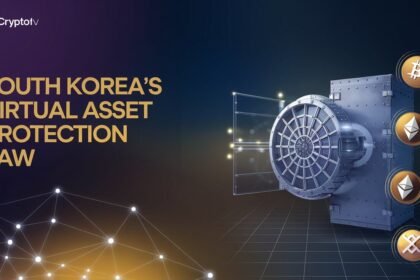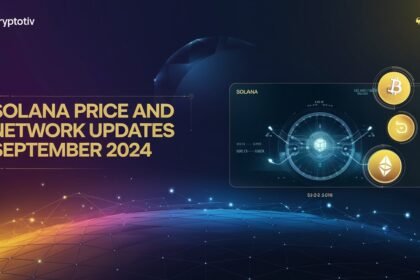The world of blockchain technology is always changing, and finding ways to make it faster is key. We’re seeing big steps forward with Layer 1 scalability and Layer 2 solutions. Each update and breakthrough makes it more likely that blockchain will become a big part of our lives.
Recently, Julia Carpenter, a 33-year-old inventor, made a big discovery. She found a way to make a special foam-like material from metal. This material is much better at cooling things down, which could change how we use data centers.
Her method starts with mixing metal particles and tiny bubbles into a slurry. Then, it’s dried and heated to make a super porous material. This material is so good at cooling that it can even float. Carpenter started a company called Apheros in Switzerland to bring this tech to the world.
As blockchain keeps working on making things faster and more efficient, Carpenter’s invention is a big step forward. It shows us how blockchain could become a big part of our everyday lives. It could change how we use digital assets and could make many industries work better.
Ethereum’s Vision for Mobile Node Accessibility
Ethereum, the second-largest blockchain network, faces challenges as it grows. Yet, Vitalik Buterin, one of its co-founders, is hopeful about the future. He talks about big upgrades that will change Ethereum in the next decade and solve its scalability issues.
Vitalik Buterin’s Optimistic Outlook on Ethereum’s Future
Vitalik Buterin sees a future where you can run an Ethereum node on your phone. This would make Ethereum faster and more decentralized by letting more people join the network. Developers are working on “light computations” to make smartphones handle the network’s tasks.
Democratizing Ethereum Through Mobile Phone Nodes
Mobile phone nodes could make Ethereum more open to everyone. Users could help verify transactions and secure the blockchain without needing expensive gear or special skills. This would help scale decentralized apps and manage blockchain traffic better.
More users in the network would spread out the workload, making the network more efficient. This would also improve how well the network performs, as it wouldn’t depend so much on a few powerful nodes.
Technological Advancements Enabling Lightweight Nodes
To make mobile phone nodes a reality, Ethereum developers are looking into new Layer 2 solutions and ZK rollups blockchain tech. These technologies aim to make nodes less heavy while keeping the network secure and decentralized.
By making the blockchain more scalable and improving node performance, Ethereum is moving towards a future where anyone can run nodes on their phones. This could make the blockchain more accessible and inclusive, closer to Buterin’s vision.
BlackRock’s Dominant Position in Ethereum ETFs
BlackRock has become a top player in Ethereum exchange-traded funds (ETFs). They manage 336,058 ETH, worth $763.95 million. This shows their strong commitment to Ethereum investments. They are the main ETF provider buying Ethereum, even when many investors are losing interest.
BlackRock’s Significant Ethereum Purchases Amid Market Challenges
BlackRock is buying a lot of Ethereum despite the market’s problems. These include unclear rules, economic issues, and ups and downs in prices. They believe in Ethereum’s future and its growth potential. Their big investment in Ethereum shows they think it will grow and improve how apps and smart contracts work.
Waning Investor Interest in Ethereum ETFs
BlackRock’s moves are interesting, but many investors are losing interest in Ethereum ETFs. In just 30 days after their launch in late July, these ETFs lost $480 million. This shows investors are getting cautious, maybe because Ethereum’s value has dropped and the market’s mood is down.
Ethereum’s Underperformance Compared to Bitcoin and Solana
Ethereum’s value hasn’t done well this year. It’s down 0.54%, while Bitcoin went up 28% and Solana 25%. This makes it hard for Ethereum ETFs to keep investors interested. People want better returns from other cryptocurrencies or other investments.
The Grayscale Ethereum Trust (ETHE) has also made things tough for Ethereum ETFs. When ETHE shares were unlocked, many left the fund. But Eric Balchunas, a Bloomberg Intelligence ETF analyst, thinks Grayscale’s event could help Ethereum ETFs recover.
Even with current challenges, Ethereum is still growing and improving. Its updates, like moving to a proof-of-stake system and Ethereum 2.0, could bring growth for investors. Ethereum is still a top choice for apps and smart contracts, thanks to its ongoing innovation.
Blockchain Scalability Breakthrough: Innovative Metal Foam Heat Sink
Julia Carpenter has made a big leap forward in blockchain scalability. She invented a way to make a highly porous metal foam at a lower cost. This could greatly improve how fast and efficient blockchain networks work by making electronics that run them cooler.
Her method starts with a mix of metal particles and tiny bubbles. After drying, heating solidifies the material into a light, porous metal foam. This new material has a surface area much bigger than before. It’s perfect for cooling down electronics that help blockchain work faster.
Julia Carpenter’s Cost-Effective Metal Foam Invention
Metal foams have been around for nearly a century, but making them was hard and expensive. Carpenter changed that with a simple, affordable way to make this material. This could really speed up how fast blockchain works.
Potential Impact on Cooling Systems for Electronics and Industries
This metal foam is great at cooling because it has a huge surface area. It could cut down the energy needed to cool things like microprocessors. Since data centers use a lot of energy just to stay cool, this could save a lot of energy and make blockchain faster.
This technology could also change cooling in many industries, not just blockchain. It could be used in advanced electronics, cars, and more. This would make things work better and use less energy.
Apheros: Bringing the Technology to Market
Carpenter started Apheros in Switzerland to bring her tech to the market. Right away, many companies wanted to use this new metal foam to cool things better.
With Apheros, Carpenter’s invention could really change how blockchain works. It could make cooling systems better, which would help blockchains work faster and handle more transactions at once.
Her metal foam could change not just blockchain, but also how many industries cool their systems. Julia Carpenter’s work shows how innovation can lead to big changes in technology and help us use resources better.
Ling: The Latest Meme Token Revolutionizing Crypto Earning Models
Panda Ling is the newest meme token on the TRON blockchain. It’s changing the way we earn in crypto with its Tap2Earn and Task2Earn platform. This platform uses blockchain technology to let users earn $LING tokens by doing daily tasks through a Telegram app. Thanks to TRON’s scalability, low transaction fees, and fast transaction speeds, using Ling is smooth and worry-free.
The way Ling works, called “Lingnomics,” focuses on lasting success and community support. It has 10 billion $LING tokens in total, with 80% for rewards. The presale gets 4%, the team 3%, liquidity 5%, and KOLs 3%. The presale has 8 rounds, starting with 400 million tokens at $0.014 USD each. It has a soft cap of $2.5 million and a hard cap of $15 million, making it easy to join without KYC checks.
Ling combines memes, gaming, and blockchain technology to make earning crypto fun and easy for everyone. Its success in solving the scalability problem blockchain faces shows the progress in making blockchain networks better. As Layer 2 network growth and rollup scalability improve, Ling leads in solving blockchain scalability issues and achieving blockchain technical breakthroughs. With its fresh take on crypto earning models and strong TRON blockchain base, Ling is set to change the meme token scene and beyond.



















